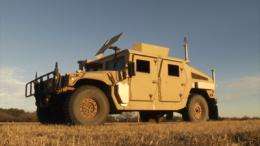Low-Profile Direction Finding Antenna Set for Ground Vehicles

(PhysOrg.com) -- The ability to identify and locate enemy forces from a single moving vehicle is a challenging yet potentially life-saving capability for today's warfighters.
Southwest Research Institute engineers designed the AVM-375 low-profile antenna set to overcome the challenges of identifying and locating the source of communications signals from a vehicle-mounted direction finding system on the move. As part of a Transportable Direction Finding (TDF) equipment series, this antenna set consists of four specially designed antennas distributed around the body of the vehicle to reduce the visible signature of the array.
"Most DF antennas are mounted on an extended mast to avoid signal perturbations associated with rooftop clutter; however, this creates a more obvious target for enemy threats and limits vehicle mobility," said Patrick Siemsen, a principal engineer in SwRI's Signal Exploitation and Geolocation Division. "The AVM-375 improves mission stealth and vehicle mobility while providing geolocation of enemy forces from a single moving platform. Multiple platforms can be networked to provide enhanced DF and geolocation."
The antenna set provides real-time, 360-degree direction finding across two frequency bands, covering 120 MHz to 3 GHz.
"The direction finding data from the system are highly accurate," Siemsen said. "The DF error is typically less than five degrees across the VHF and UHF frequency bands." SwRI's mobile DF processor and a unique algorithm assemble and process data from the distributed arrays.
"Our state-of-the-art processor is compact, weighing about 10 pounds and consuming less than 30 watts of power," Siemsen said. "The brick-sized package offers wideband functionality, rapid frequency scanning operations and DF of simultaneous signals. Multiple operator displays and interfaces can be run from a single processor."
Once the antennas are installed on a given vehicle, the DF system is calibrated using a test target and GPS tracking software, and the calibration data can be ported to systems installed on similar vehicles without requiring recalibration.
For more than 50 years, Southwest Research Institute has designed, fabricated and assembled precision HF, VHF and UHF direction-finding equipment, particularly for shipboard and other permanent installations. Recently, SwRI engineers have been developing a class of lighter-weight, lower-profile systems for vehicle-mounted, drone-borne, wearable and backpack applications.
Provided by Southwest Research Institute


















